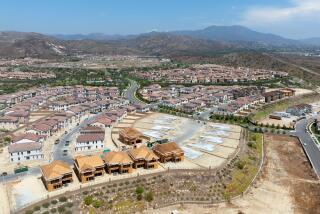Homes Costs Cut Growth in Cities : Demographics: Second-generation suburbanites can’t afford their parents’ north Orange County residences, a state study reveals.
SACRAMENTO — Once among the fastest-growing areas of California, northern Orange County has barely maintained--or even lost--population during the 1980s because a second generation of suburbanites can’t afford their parents’ homes, according to a report released Thursday.
The report issued by Gov. Pete Wilson’s Council on Growth Management also says the character of Orange County has changed dramatically, from a one-time bedroom community for Los Angeles to an “economic powerhouse” that has more high-tech jobs than workers.
The report paints a broad picture of California’s changing demographic landscape, where an unprecedented surge of 6 million people over the last decade has pushed the total population to nearly 30 million.
In Southern California, that growth reversed population declines in the core of Los Angeles and fueled population booms in new, outlying “exurbs”--essentially suburbs of suburbs carved out of Riverside and San Bernardino counties.
But the escalating prices of homes in the traditional neighborhoods of Orange County, built between the 1940s and 1970s, are actually driving people away, the report says.
“For instance, Orange County was California’s quintessential suburb, a county that grew by 101% in the 1960s alone,” the report says. “In the 1980s, the northern part of Orange County slowed to almost no growth, and four cities actually lost population.”
The combined population loss of 3,121 in Fountain Valley, Seal Beach, Villa Park and La Palma is symptomatic of what the report calls the “emptying of the nest.”
Areas settled by affluent suburbanites after World War II not only lose their original owners to death or retirement communities but are losing the second generation of suburbanites as well to rising house prices, it says. The median home price in Orange County is $236,720.
“Many young suburbanites today cannot afford housing in Atherton, Villa Park or Palos Verdes,” the report says. “Even if both spouses work, they must live far from the city center or suburban office park and often commute distances their parents rightly would have thought absurd. . . . “
The problem is compounded by the fact that Orange County “has become an economic powerhouse itself as high-technology industries have clustered in the suburbs.” With a surplus of 64,000 jobs, Orange County now must import laborers--who come from the exurbs.
“For a suburban county with a freeway system designed and built to support commuting to Los Angeles, a sudden influx of workers from another direction, and as far away as Riverside and San Bernardino, heavily taxes a highway system never intended for suburban-to-suburban commuting,” the report says.
“This also explains why rush hour in Orange County is all hours of the day, in all directions, on all freeways,” the report says.
The report noted, however, that not all of Orange County was stagnant. Yorba Linda and Irvine were among the fastest-growing cities during the 1980s, gaining 85% and 77% respectively.
More Californians
Here is a look at some sources of population growth in California between 1985 and 1990, according to a study by the Council on Growth Management:
Natural increase (births over deaths): 290,000 (45%)
Domestic migration: 108,000 (17%)
Immigration from abroad: 252,000 (38%)
Legal: 160,000
Other: 92,000
Total: 650,000 (100%)
SOURCE: Department of Finance
More to Read
Sign up for Essential California
The most important California stories and recommendations in your inbox every morning.
You may occasionally receive promotional content from the Los Angeles Times.










